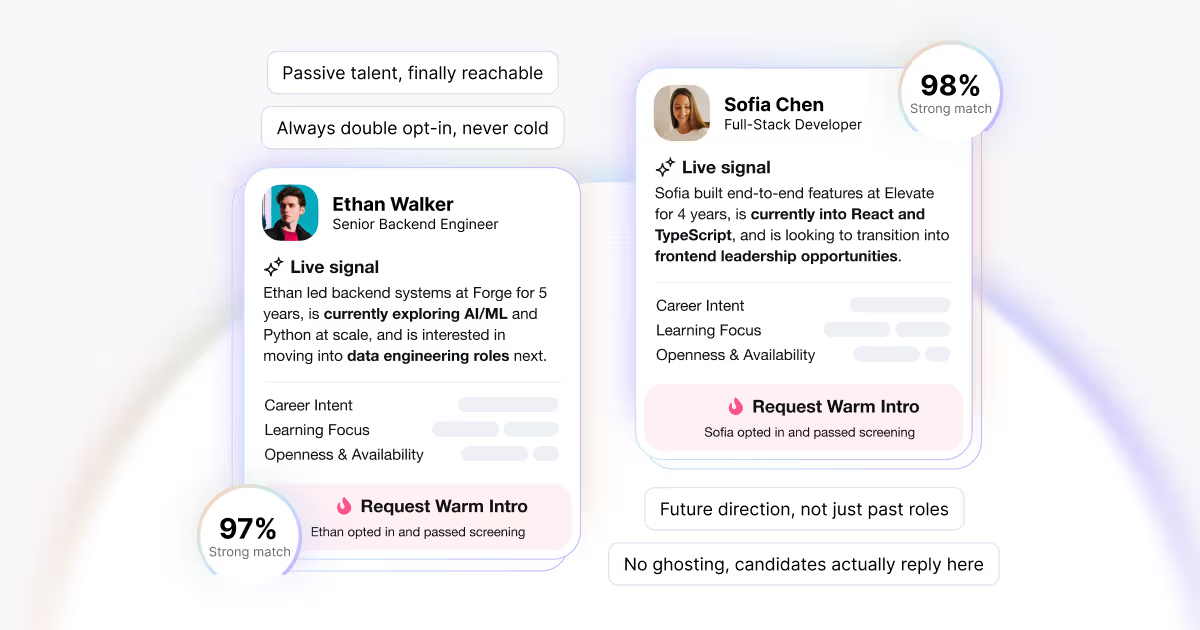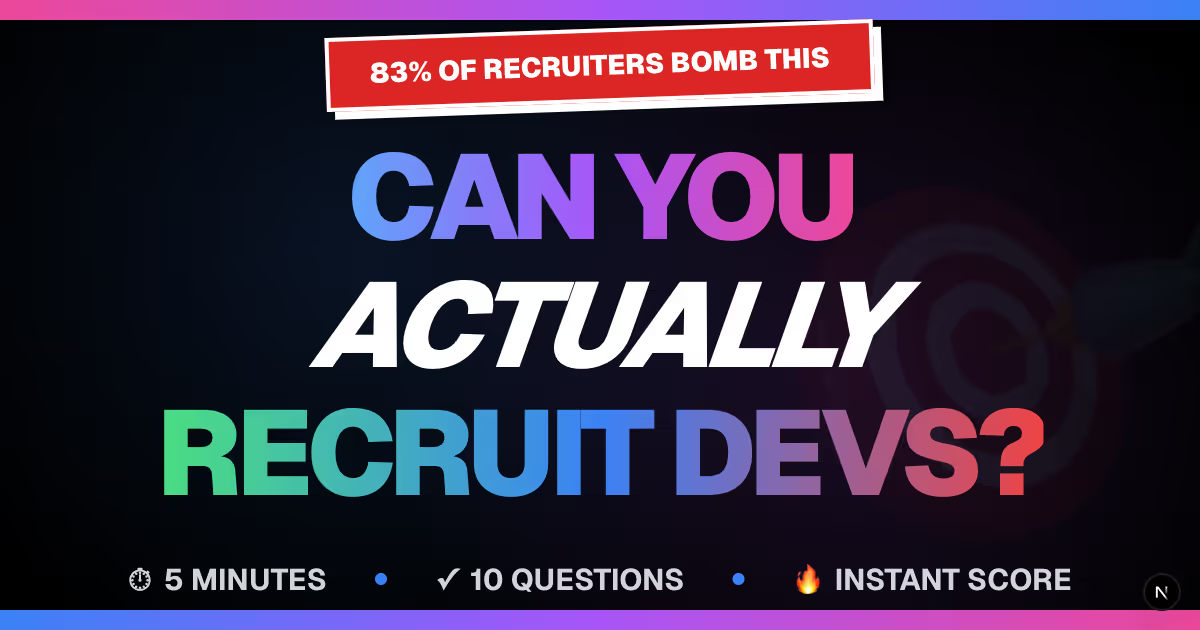


Learn how to create transparent developer job posts that attract top talent by clearly outlining roles, responsibilities, and compensation.
<article>
Writing A Job Description With AI
Writing Transparent Developer Job Posts: Key Takeaways
Transparent job posts help developers understand roles better by clearly outlining responsibilities, expectations, and compensation. This approach attracts qualified candidates, reduces mismatches, and builds trust. Here's how to make your job posts developer-friendly:
- Job Title and Role Clarity: Use specific titles (e.g., "Senior Full-Stack Developer - React/Node.js") and clearly define responsibilities and required skills. Separate "must-have" and "nice-to-have" qualifications.
- Company Overview: Share your mission, values, and how your team works. Highlight workflows, code review practices, and decision-making processes.
- Project Context: Explain what the role involves, including the tech stack, challenges, and impact on the company’s goals. Be clear about the type of projects and their significance.
- Responsibilities and Metrics: Detail daily tasks and success benchmarks (e.g., "Reduce application load time by 20%"). Include team dynamics, project timelines, and Agile practices if applicable.
- Compensation and Benefits: Always include a salary range (e.g., "$120,000–$150,000 annually") and details about bonuses, equity, health insurance, remote work options, and professional development perks.
Formatting Tips:
- Use bold text for key details like salary and required skills.
- Organize information with bullet points for readability.
- Tables can simplify complex details like compensation breakdowns or skill requirements.
Final Checklist:
- Use clear, direct language without jargon.
- Get feedback from technical peers to ensure accuracy.
- Double-check formatting and legal compliance (e.g., salary transparency laws).
Transparent job posts not only attract top talent but also create a positive hiring experience, which developers value. </article>
Core Components of a Transparent Developer Job Post
A well-crafted developer job post does more than just list requirements - it provides a complete picture of the opportunity at hand. Each element plays a crucial role in helping developers make informed decisions. Below, we break down the key components that turn an ordinary job listing into one that's clear, engaging, and developer-friendly.
Clear Job Title and Role Definition
The job title is often the first thing developers notice, so it’s important to get it right. Avoid vague titles like "Software Engineer" or overly gimmicky ones like "Code Ninja." Instead, be specific about the seniority, specialization, and key technologies involved. For example, "Senior Full-Stack Developer - React/Node.js" immediately communicates the level of expertise required and the primary tech stack.
When defining the role, be precise about the type of work involved. Are you looking for someone to focus on user interfaces, handle system architecture, or work across the entire stack? Mention whether the role involves building new systems, maintaining legacy code, or migrating existing applications. This level of detail helps developers quickly assess if their skills and interests match the position.
Equally important is clarity around technical requirements. Rather than overwhelming candidates with an exhaustive list of tools and frameworks, focus on the essentials. Clearly distinguish between "must-have" skills (e.g., three years of React experience) and "nice-to-have" proficiencies (e.g., familiarity with GraphQL). This transparency ensures candidates understand what’s truly important for the role.
Once you've nailed the role definition, it’s time to give developers a glimpse into your company and its culture.
Detailed Company Overview
The company overview is your chance to connect with developers by offering a concise yet meaningful snapshot of your organization. Developers want to know what drives your company and how technology plays a role in achieving your goals.
Start by outlining your mission and values, as well as your position in the industry. Are you a rapidly growing fintech startup, a well-established healthcare platform, or a company specializing in developer tools? This context helps candidates understand the environment they’d be stepping into.
Culture is especially important to developers. Share insights into how your team approaches code reviews, deployment practices, and decision-making processes. Do you prioritize innovation, stability, or a balance of both? These details help paint a picture of what it’s like to work on your team.
"Lead with honesty, relevance, and respect, and you'll stand out in a sea of copy-paste InMails." - Nimrod Kramer, September 21, 2025
Project and Product Context
Developers want to know what they’ll be working on and why it matters. Be upfront about the specific projects or product areas the new hire will contribute to. Is the focus on a customer-facing web app, an internal API, a mobile application, or infrastructure tools?
Describe the technical challenges and opportunities associated with the role. Are you scaling systems to handle more traffic, modernizing legacy codebases, or launching entirely new features? Include details about the current tech stack, development practices, and any planned initiatives. This gives candidates a sense of whether the work aligns with their career goals.
It’s also important to explain how the role impacts the bigger picture. Will the developer be creating features that enhance user experience, optimizing performance, or building tools that support other engineers? Understanding the broader impact of their work helps candidates see the value in the role.
Once the project scope is clear, outline what the daily responsibilities will look like.
Responsibilities, Expectations, and Success Metrics
Be specific about the day-to-day tasks. Instead of vague descriptions, provide concrete examples like "Develop responsive React components for the customer dashboard", "Design and implement RESTful APIs for mobile app integration", or "Collaborate with the DevOps team to streamline deployment pipelines."
Clarify the reporting structure and team dynamics. Who will the developer work with most frequently? How large is the engineering team? What are the typical project timelines and release cycles? If your team follows Agile methodologies, explain what that looks like in practice.
Set clear expectations by sharing success metrics. For instance, instead of generic goals, outline measurable outcomes like "Launch two major features per quarter", "Ensure code review turnaround times stay under 24 hours", or "Reduce application load time by 20%." These benchmarks help candidates understand how their performance will be evaluated.
Compensation and Benefits
Transparency around compensation is crucial. Always include a clear salary range in USD (e.g., "$120,000 – $150,000 annually"). If the range varies based on factors like experience or location, explain how those variables come into play.
In addition to salary, outline other financial elements like equity options, bonuses, retirement plans, and unique perks. For instance, if stock options are part of the package, provide details about the vesting schedule.
Don’t forget to highlight benefits that matter to developers. These might include health insurance, retirement contributions, professional development budgets, or remote work options. Flexible hours, vacation policies, and perks like training stipends or equipment budgets can also make a difference. Developers value opportunities to grow and thrive, so be sure to emphasize any investments you make in their professional development.
"Give developers control with transparent, personalized opportunities." - daily.dev Recruiter
Step-by-Step Checklist for Writing Transparent Job Posts
Creating a clear and transparent job post is essential to attract the right candidates. Use this concise checklist to ensure your job post includes all the necessary details without missing anything important.
Use Clear and Direct Language
Stick to straightforward language and steer clear of corporate buzzwords or internal jargon. For instance, instead of saying "synergize cross-functional deliverables", opt for something like "work with product and design teams to develop new features."
Write in an active voice to keep the tone engaging and clear. For example, say "Maintain and improve existing codebases" rather than "Responsibilities will include the maintenance of legacy systems." Keep sentences short and break down complex ideas into easy-to-understand statements.
Once your content is clear, focus on formatting for readability.
Bold and Format Key Information
Formatting can make key details stand out. Use bold text to highlight critical information like required qualifications, salary ranges, and benefits. For example:
Salary: $120,000–$140,000/year (USD)
Organize important details with bullet points for quick readability:
Required Skills:
- JavaScript and React (3+ years)
- Node.js and Express
- Experience with PostgreSQL or similar databases
Benefits:
- Health insurance with company contribution
- 401(k) with 4% company match
- Fully remote with core working hours: 10:00 AM–4:00 PM (PST)
This kind of formatting can significantly improve clarity and even boost application rates - well-structured job posts with bullet points can increase applications by up to 30%. Keep the formatting consistent throughout for a polished, professional look.
After formatting, take the time to ensure your post is accurate and easy to understand.
Get Peer Review for Clarity and Accuracy
Before hitting publish, ask a colleague with technical knowledge to review your job post. Whether it's someone from your engineering team or a technical recruiter, their feedback can help identify inaccuracies, unclear requirements, or missing details that might confuse potential candidates.
Encourage reviewers to flag any jargon or ambiguous language. It's also helpful to get input from someone outside your hiring team to ensure the post is understandable to a broader audience. Once you've incorporated their feedback, do a final proofread to check for grammar, spelling, and formatting consistency.
This peer review step not only enhances the clarity of your job post but also reflects your respect for candidates' time and effort. A well-crafted, transparent job post shows your commitment to creating a positive hiring experience, which resonates strongly with the developer community - a key focus at daily.dev Recruiter.
sbb-itb-d1e6221
Matching Job Posts with Developer Expectations
Creating a job post that resonates with developers starts with transparency, but it doesn’t end there. To truly engage candidates, your post needs to reflect what developers care about most: opportunities for growth, meaningful work, and a clear sense of purpose. Developers aren’t just looking for a paycheck - they’re searching for roles that challenge them and allow them to make an impact.
Address Developer Motivations
Developers value more than just compensation. They’re drawn to roles that promise professional development, career progression, and the chance to solve meaningful problems. Your job post should highlight these areas clearly.
For instance, instead of vague phrases like "maintain existing systems", provide specifics that showcase technical challenges and growth opportunities. Say something like: "Optimize our payment processing system - handling $2 million daily - by implementing a microservices architecture." This not only emphasizes the scale of the work but also the skills they’ll develop.
Make sure to highlight mentorship and learning opportunities. If senior developers are available for code reviews, or if your company supports professional development with conference budgets or dedicated learning time, say so. For example: "Participate in weekly architecture discussions and access a $2,000 annual budget for professional development."
Clarity about career progression is equally important. Developers want to understand where the role can take them. Specify potential paths, like moving into senior developer, tech lead, or engineering manager positions, and outline the milestones or timelines involved. This gives candidates a clear picture of their future within your organization and reinforces your commitment to transparency.
Describe Team Dynamics and Tools
The day-to-day work environment matters a lot to developers. They want to know how the team operates, how decisions are made, and what tools they’ll use. A detailed overview of team dynamics and workflows can make your post stand out.
Explain your team structure and collaboration style. For example: "Join a cross-functional team of 4 developers, 1 designer, and 1 product manager. Teams have full ownership of features from conception to deployment, with minimal oversight." This kind of detail helps candidates visualize their role within the team.
Be specific about the technologies, frameworks, and tools they’ll use. Go beyond just listing programming languages. Include tools for development, deployment, and collaboration, such as: "Our daily tech stack includes React 18, Node.js, PostgreSQL, Docker, AWS, GitHub Actions for CI/CD, and Slack for team communication."
Don’t forget to outline remote work policies and core collaboration hours. Developers appreciate knowing upfront how flexible the role is and what’s expected in terms of availability.
Use Warm, High-Context Introductions
The initial connection you make with developers can set the tone for the entire hiring process. Traditional recruiting often feels impersonal, leaving candidates disengaged. A thoughtful, personalized approach can make all the difference.
Platforms like daily.dev Recruiter prioritize warm, high-context introductions. Instead of relying on cold outreach or scraped profiles, this platform connects you with developers who are already engaged and interested in new opportunities. By the time you reach out, candidates have seen your job post, understand the role, and are open to a conversation. This eliminates the awkwardness of cold emails and allows you to jump straight into meaningful discussions.
When you do connect, reference specific details from your job post that align with their interests. For example, mention the technical challenges or career growth opportunities they might have found appealing. This shows you’ve paid attention and creates a more personalized, engaging experience - something developers genuinely appreciate.
Formatting and Presentation Guidelines
When it comes to crafting a job post, presentation matters just as much as the content itself. Clear and consistent formatting not only helps developers quickly find the details they need but also conveys a sense of professionalism. Poorly formatted posts can bury key information or make your listing appear unpolished - both of which can turn candidates away.
Use Tables to Simplify Information
Tables are a great way to organize complex details into an easy-to-read format. Instead of cramming requirements or benefits into long paragraphs, a table allows developers to scan and compare information quickly.
For example, you can use a table to clearly distinguish between required and preferred skills:
| Required Skills | Preferred Skills |
|---|---|
| JavaScript (ES6+) | TypeScript |
| React.js | Next.js |
| RESTful API design | GraphQL |
| Git | CI/CD experience |
| 3+ years of experience | Open source contributions |
Another effective use of tables is breaking down compensation details:
| Compensation Component | Amount |
|---|---|
| Base Salary | $110,000–$130,000 |
| Annual Bonus | Up to 15% of base |
| Equity | 0.1%–0.25% |
| Sign-on Bonus | $10,000 |
Tables work best when you have multiple categories of information that candidates need to evaluate side by side. They make your post more scannable and save time for readers.
Stick to US Formatting Standards
Using consistent US formatting shows attention to detail and avoids potential confusion.
- Currency: Always include the dollar sign and use comma separators (e.g., $120,000). For ranges, use an en dash (e.g., $110,000–$130,000).
- Dates: Use the month/day/year format, such as 09/29/2025 or September 29, 2025. Avoid formats like 29/09/2025.
- Numbers: Use commas for thousands and periods for decimals (e.g., 1,000 users, 3.5 years).
- Measurements: Stick to imperial units, such as square feet for office space, miles for distances, and Fahrenheit for temperature.
These small details make your post easier to understand and reflect a professional approach.
Maintain Consistency Across Sections
Consistency is key to making your job post easy to navigate. A predictable structure helps candidates focus on the content rather than deciphering the layout.
- Headers: Use a consistent style for main sections and subsections throughout your post.
- Bullet points: Use these for lists like responsibilities, qualifications, or benefits. Avoid mixing bullet points with numbered lists unless there’s a clear reason.
- Bold key details: Highlight critical information like salary ranges, job titles, required skills, and years of experience to draw attention.
- White space: Break up dense blocks of text with short paragraphs and ample spacing. This improves readability and keeps candidates engaged.
Consistency in terminology is equally important. For instance, if you mention "3+ years of experience" in one section, avoid switching to "three or more years" elsewhere. Keeping phrasing uniform reinforces clarity.
According to LinkedIn Talent Solutions (2023), job posts with clear formatting and transparent salary details attract up to 30% more qualified applicants. Similarly, a 2022 Glassdoor study found that 67% of job seekers prioritize salary transparency and easy-to-read formatting when deciding whether to apply.
Before hitting "publish", take the time to review your job post section by section. Ensure each part follows the same structure, uses consistent terminology, and presents information in a way that’s easy to scan. This attention to detail shows candidates that you value professionalism and care about their experience - qualities that won’t go unnoticed.
Final Review Checklist and Summary
Before you publish your developer job post, take a moment to ensure it’s clear, transparent, and aligned with developer expectations. A transparent job post doesn’t just grab the attention of top talent - it also shows your commitment to honest communication, which is key to successful recruitment. A well-written job description can make all the difference between attracting skilled candidates and losing them to unclear messaging.
Key Transparency Elements to Check
Your job post should address the main questions developers are likely to ask:
- What will I be building?
- Who will I work with?
- What is the compensation?
These answers are crucial for building trust right from the start.
Your company overview should give candidates a clear sense of your mission, team size, and workplace culture. Include specifics about your product, user base, and recent achievements - backed by metrics that highlight your company’s growth and success.
Clearly explain the project context so developers know what they’re signing up for. Outline the systems they’ll work on, the challenges they’ll tackle, and how their contributions will drive the company’s goals forward.
Make sure compensation details are upfront and formatted in USD. Be specific - include base salary ranges, equity options, performance bonuses, and valuable perks like professional development funding, conference opportunities, flexible schedules, and top-notch equipment.
Once these elements are covered, use the following tips for a final review before hitting publish.
Final Review Tips
Before you go live with your job post, run through this checklist:
- Read it aloud. If it feels too formal or overly corporate, simplify the language. Developers appreciate straightforward, honest communication over marketing jargon.
- Double-check technical details. Verify all technical aspects with your engineering team and have an engineer review the post to ensure it aligns with the actual role.
- Check formatting consistency. Make sure salary ranges use proper US formatting (e.g., $110,000–$130,000), dates follow the US standard format (e.g., 09/29/2025), and headers are styled uniformly.
- Ensure legal compliance. Confirm your post adheres to current salary transparency laws to avoid any legal complications.
FAQs
How can I make sure my job post complies with salary transparency laws in the US?
To meet the requirements of salary transparency laws in the US starting in 2025, make sure your job listings include a clear salary range or starting pay. Many states mandate this, particularly for companies with 15 or more employees. Additionally, several laws restrict employers from inquiring about a candidate's salary history.
These regulations are also set to broaden in some areas, potentially covering internal promotions and transfers. For instance, states like Massachusetts and Vermont will implement their specific rules later in 2025. It’s crucial to stay informed about both local and state laws to keep your job postings compliant.
How can I effectively showcase company culture in a developer job post?
To showcase your company culture in a developer job post, aim to be both genuine and detailed. Talk about what makes your team unique - whether that's how you collaborate, the work environment you foster, or the values you prioritize, like flexibility, creativity, or teamwork.
Highlight perks that align with your culture. For instance, if you value growth, mention learning opportunities or mentorship programs. If flexibility is key, point out remote work options or flexible hours. Real-life examples, like a story about a developer's career growth or a standout team project, can make your culture feel more tangible and relatable.
Finally, let your company’s personality shine through in your tone. Whether your vibe is casual and fun or more polished and focused, using language that matches your culture helps create a consistent and appealing message for developers.
Why is it important to clearly separate 'must-have' and 'nice-to-have' skills in developer job postings?
Clearly distinguishing between "must-have" and "nice-to-have" skills in job postings plays a key role in attracting the right candidates while avoiding unnecessary hurdles. This separation allows employers to focus on the essential qualifications needed for the role while remaining open to candidates who may bring additional, complementary skills to the table.
When recruiters prioritize core competencies, it simplifies the hiring process, reduces the risk of overlooking qualified developers, and makes job descriptions more inclusive. It also helps set clear expectations for candidates, promoting transparency and building trust throughout the hiring process.
Related Blog Posts








